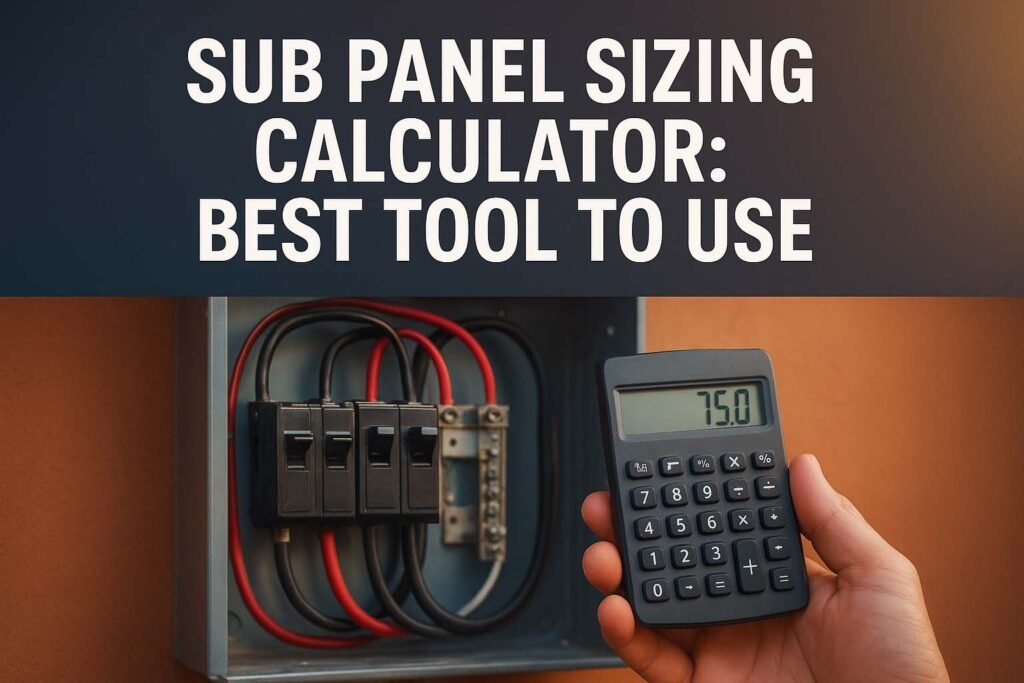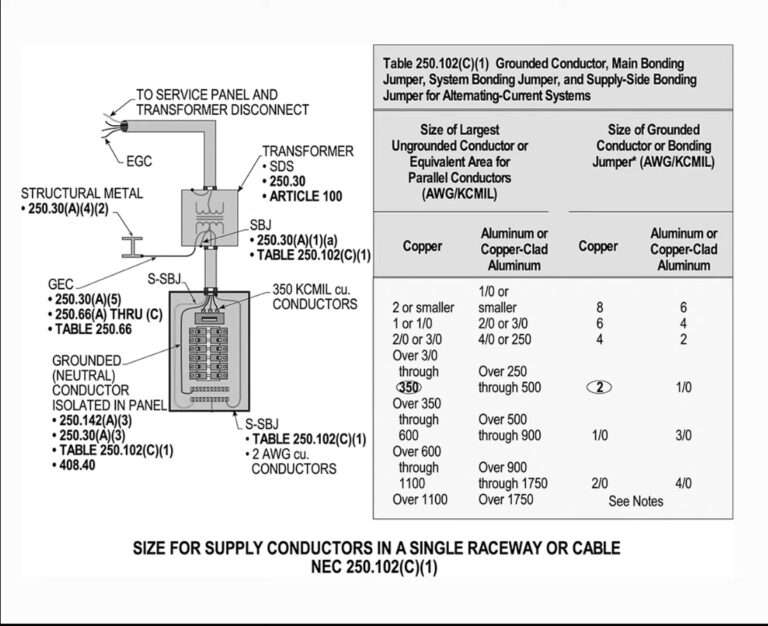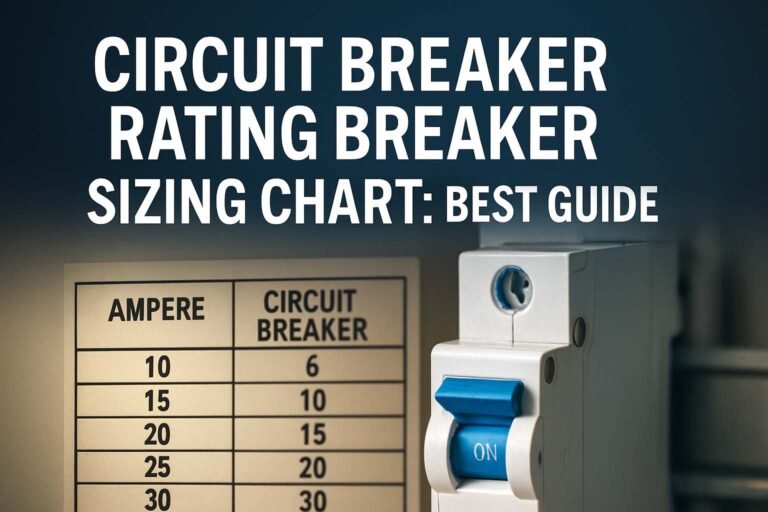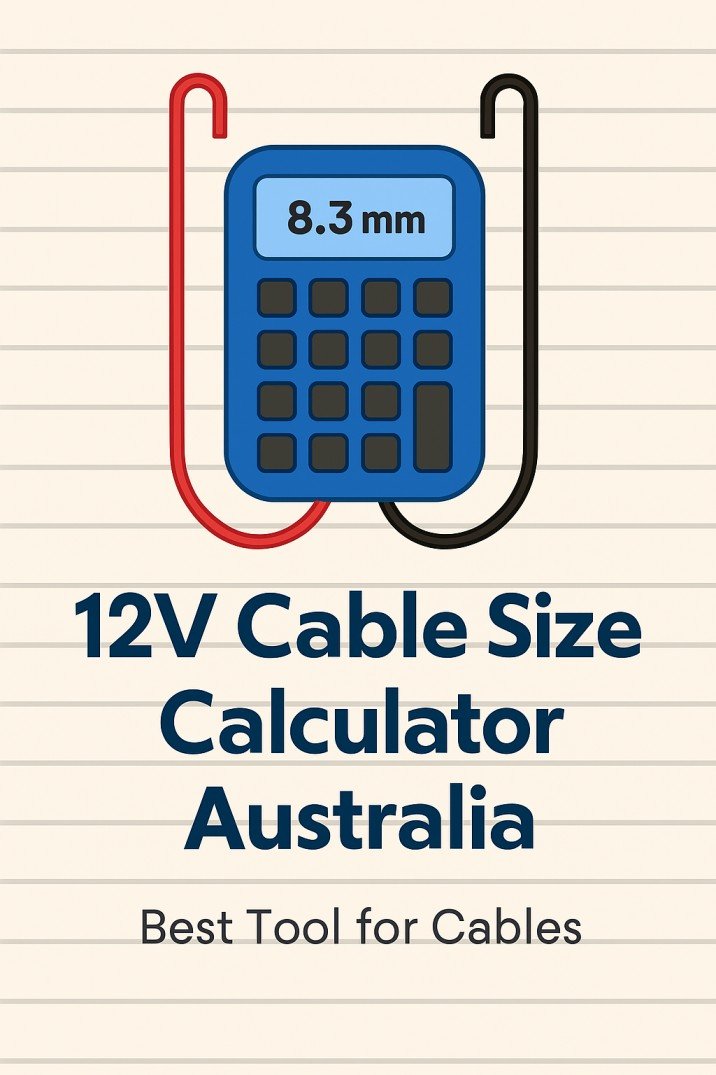Sub Panel Sizing Calculator: Best Tool to Use
When planning an electrical upgrade or new installation, one of the most common questions people ask is how to correctly size a sub panel. A sub panel provides additional circuits and load distribution for a home, workshop, garage, or commercial building. The challenge is not just choosing the right amperage for the sub panel, but also selecting the right wire size and breaker ratings to ensure safety and compliance with the National Electrical Code (NEC). This is where a sub panel sizing calculator becomes extremely useful.
Table of Contents
Table of Contents

Before we dive into technical calculations, it is important to understand that sub panels are not independent service panels. They are extensions of your main electrical service, which means that improper sizing can cause overheating, nuisance tripping, and even electrical fires. For those who want to quickly determine proper wire sizes and load distribution, you can also check our detailed sub panel wire size calculator and electrical service calculator which simplify the process by using standard NEC formulas.
The main goal of this guide is to explain how to use a sub panel sizing calculator effectively, provide technical insights, and ensure your electrical system is both safe and future-proof. By the end, you will have a clear idea of how to calculate loads, select wire sizes, and determine the right breaker for your sub panel installation.
Key Takeaways:
- A sub panel sizing calculator helps determine correct panel amperage and wire size.
- Proper calculation prevents overloading, voltage drop, and fire hazards.
- The NEC requires calculations based on continuous and non-continuous loads.
- Choosing the right sub panel size ensures safe and efficient electrical distribution.
Use our online tool Power Factor Correction Capacitor Calculator – Complete Technical Guide
What is a Sub Panel and Why Do You Need One?
A sub panel is essentially a secondary electrical panel that branches off from the main service panel. It is connected by a feeder breaker in the main panel and supplies electricity to specific areas. Homeowners often install sub panels for detached garages, workshops, home offices, or extensions. In commercial setups, sub panels are used to distribute loads across different sections of a building.
The most important function of a sub panel is load management. Instead of running multiple circuits directly from the main service, you can connect them to the sub panel, reducing clutter and providing localized control. However, this only works efficiently if the sub panel is sized correctly. Using a sub panel sizing calculator ensures you do not undersize or oversize your panel, both of which can create issues.
How a Sub Panel Sizing Calculator Works
A sub panel sizing calculator is based on NEC guidelines for load calculation. The calculator takes into account:
- Total connected load in watts (appliances, lighting, outlets, HVAC).
- Type of load (continuous or non-continuous).
- Voltage (120V, 240V, or 3-phase).
- Distance from main panel to sub panel (for voltage drop consideration).
- Wire size based on amperage and distance.
The formula commonly used is:
Amps = Watts ÷ Volts
For example, if your total load is 9600W on a 240V sub panel:
Amps = 9600 ÷ 240 = 40 Amps
In this case, you would need at least a 40A sub panel. However, electricians typically size the panel higher for safety, meaning you might select a 60A panel to allow for future expansion.
Load Calculation for Sub Panels
Load calculation is the most important step. The NEC specifies that continuous loads must be calculated at 125% of their rated value. This ensures the sub panel does not overheat when equipment runs for three hours or more.
Here’s a simple example:
| Appliance / Circuit | Wattage | Continuous? | Adjusted Wattage |
|---|---|---|---|
| Lighting (10 fixtures) | 1200W | Yes | 1500W |
| Refrigerator | 800W | No | 800W |
| Air Conditioner | 3000W | Yes | 3750W |
| Workshop Tools | 4000W | No | 4000W |
| Miscellaneous Outlets | 1500W | No | 1500W |
| Total Load | 10,500W | – | 11,550W |
Now divide the adjusted total load by 240V:
Amps = 11,550 ÷ 240 = 48.1 Amps
In this case, a 60A sub panel would be the correct choice.
Use our online tool Circuit Breaker Size Calculator: Best Tool for Engineers
Choosing Wire Size for Sub Panels
Once you determine the amperage, the next step is selecting the proper wire size. A sub panel sizing calculator also provides this information based on ampacity tables and distance. Wire size is crucial because undersized conductors cause voltage drop and overheating.
Here is a quick reference table:
| Sub Panel Amps | Minimum Copper Wire Size | Minimum Aluminum Wire Size |
|---|---|---|
| 30A | 10 AWG | 8 AWG |
| 60A | 6 AWG | 4 AWG |
| 100A | 4 AWG | 2 AWG |
| 125A | 2 AWG | 1/0 AWG |
| 150A | 1 AWG | 2/0 AWG |
| 200A | 2/0 AWG | 4/0 AWG |
For runs longer than 100 feet, voltage drop becomes a concern. A good rule of thumb is to increase the wire size by one level if the distance exceeds 100 feet. For example, a 60A sub panel normally requires 6 AWG copper, but if it is 150 feet away from the main panel, you should use 4 AWG copper instead.
Breaker Sizing for Sub Panels
The breaker that feeds the sub panel must match the ampacity of the feeder wires. For example, if you are using 6 AWG copper wire rated for 60A, you must use a 60A breaker in the main panel. Using a larger breaker than the wire rating is a common mistake and can lead to dangerous overheating.
Also, keep in mind that the breaker in the main panel protects the feeder wires, not the sub panel itself. The sub panel will have its own breakers to protect individual circuits.
Common Sub Panel Sizes and Applications
Most homeowners and contractors choose between three main sizes of sub panels:
- 60A Sub Panel – Commonly used for garages, small workshops, or additional lighting and outlet circuits.
- 100A Sub Panel – Suitable for large workshops, small apartments, or areas with multiple high-demand appliances.
- 125A–200A Sub Panel – Ideal for large extensions, commercial applications, or separate living units.
For example, if you are adding an EV charger and multiple high-power tools to your garage, a 100A sub panel with 4 AWG copper feeders would be the best choice.
Use our online tool Watt to Amp Calculator (Single & Three-Phase): Best Tool
Safety and Code Compliance
Electrical safety should always be the priority. A sub panel sizing calculator gives you accurate numbers, but you must also follow NEC rules:
- Always separate neutral and ground in the sub panel.
- Use four-wire feeders (hot-hot-neutral-ground).
- Bond ground to the sub panel chassis, but never bond neutral and ground together in the sub panel.
- Always size conductors and breakers according to the weakest link principle.
Advantages of Using a Sub Panel Sizing Calculator
Using a sub panel sizing calculator provides multiple benefits:
- Saves time by avoiding manual NEC calculations.
- Prevents undersizing or oversizing of panels.
- Helps estimate future load expansion.
- Provides accurate wire size and breaker requirements.
- Improves safety and compliance with NEC standards.
Example Scenario: Garage Sub Panel
Suppose you want to install a sub panel in your garage to power:
- Lighting: 800W
- Power Tools: 4000W
- Air Compressor: 3000W
- Heater: 5000W
Total = 12,800W
Adjusted for continuous loads = 14,000W
Amps = 14,000 ÷ 240 = 58.3A
You would select a 60A sub panel with 6 AWG copper wire. If the garage is 120 feet away, upgrade to 4 AWG copper to minimize voltage drop.
Use our online tool AWG to mm² Calculator – Convert Wire Sizes Easily and Accurately
Why Proper Sub Panel Sizing Matters
Incorrect sub panel sizing can lead to multiple issues:
- Overloaded wires and breakers.
- Tripped breakers during heavy appliance usage.
- Voltage drops causing equipment malfunction.
- Fire hazards due to overheated conductors.
On the other hand, a correctly sized sub panel ensures smooth power distribution, reliable operation, and long-term safety.
Use our online tool Electrical Conduit Fill Calculator and Conduit Wire Fill Chart
Conclusion
Sizing a sub panel is not just about guessing the amperage. It requires careful load calculations, wire sizing, breaker selection, and compliance with NEC standards. A sub panel sizing calculator simplifies the process, making it easier for both homeowners and electricians to design safe and reliable systems.
For quick and accurate results, make sure to check out our sub panel wire size calculator and electrical service calculator which provide step-by-step sizing based on your load requirements. With the right approach, your sub panel will not only meet today’s needs but also handle future electrical demands with confidence.
Follow Us on Social:
Subscribe our Newsletter on Electrical Insights for latest updates from Electrical Engineering Hub
#SubPanelSizingCalculator, #ElectricalService, #PanelBoardSizing, #ElectricalCalculator, #HomeWiring, #ElectricalSafety, #LoadCalculation, #ElectricalDesign, #CircuitBreakerSizing, #ElectricalPanel, #PowerDistribution, #DIYElectrical, #ElectriciansGuide, #ElectricalEngineering, #WiringCalculator






